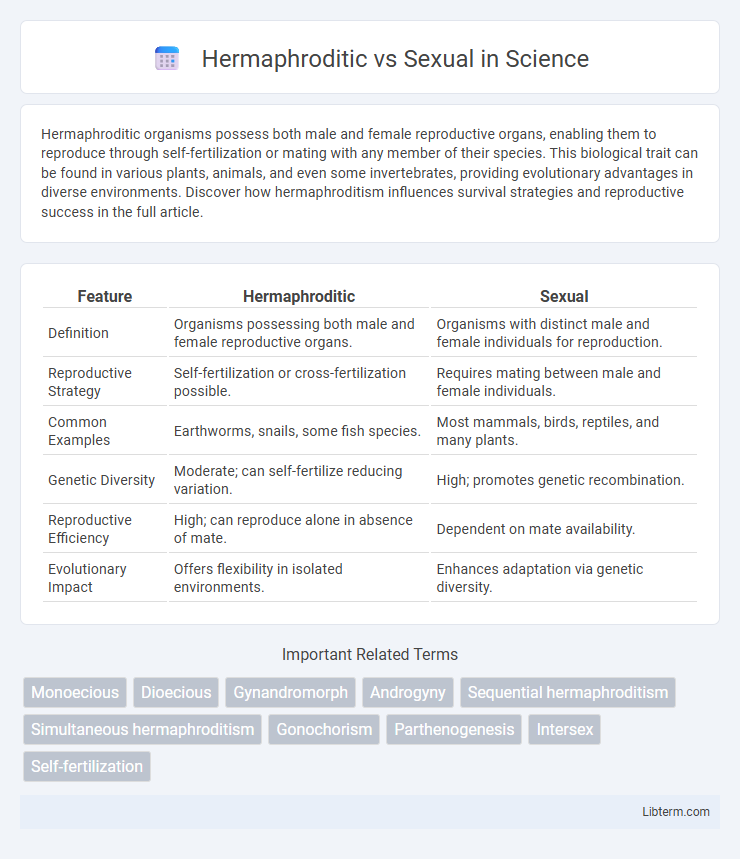Hermaphroditic organisms possess both male and female reproductive organs, enabling them to reproduce through self-fertilization or mating with any member of their species. This biological trait can be found in various plants, animals, and even some invertebrates, providing evolutionary advantages in diverse environments. Discover how hermaphroditism influences survival strategies and reproductive success in the full article.
Table of Comparison
| Feature | Hermaphroditic | Sexual |
|---|---|---|
| Definition | Organisms possessing both male and female reproductive organs. | Organisms with distinct male and female individuals for reproduction. |
| Reproductive Strategy | Self-fertilization or cross-fertilization possible. | Requires mating between male and female individuals. |
| Common Examples | Earthworms, snails, some fish species. | Most mammals, birds, reptiles, and many plants. |
| Genetic Diversity | Moderate; can self-fertilize reducing variation. | High; promotes genetic recombination. |
| Reproductive Efficiency | High; can reproduce alone in absence of mate. | Dependent on mate availability. |
| Evolutionary Impact | Offers flexibility in isolated environments. | Enhances adaptation via genetic diversity. |
Understanding Hermaphroditism: Definition and Types
Hermaphroditism is a biological condition where an organism possesses both male and female reproductive organs, allowing for greater reproductive flexibility. It is classified into two main types: simultaneous hermaphroditism, where both sex organs are functional at the same time, and sequential hermaphroditism, where an organism changes sex at some point in its life cycle. Understanding these types enhances insights into reproductive strategies across various species, from invertebrates like earthworms to certain fish such as clownfish.
What Is Sexual Reproduction? Key Concepts Explained
Sexual reproduction involves the combination of genetic material from two distinct gametes, typically from male and female organisms, resulting in offspring with genetic variation. This process contrasts with hermaphroditic reproduction, where a single organism possesses both male and female reproductive organs, enabling self-fertilization or mating with any individual of the species. Key concepts of sexual reproduction include meiosis, genetic recombination, fertilization, and the promotion of biodiversity through variation in offspring.
Biological Differences: Hermaphroditic vs Sexual Organisms
Hermaphroditic organisms possess both male and female reproductive organs, enabling self-fertilization or mating with any individual of their species, enhancing reproductive flexibility in environments with sparse populations. Sexual organisms have distinct male and female individuals, requiring the fusion of sperm and egg from separate organisms, which promotes genetic diversity through outcrossing. The presence of dual reproductive systems in hermaphrodites contrasts with the specialized, gender-specific organs in sexual species, reflecting fundamental biological adaptations to their reproductive strategies.
Advantages of Hermaphroditic Reproduction
Hermaphroditic reproduction allows organisms to produce offspring without the need for a mate, ensuring reproductive success in low population densities or isolated environments. This mode of reproduction enhances genetic diversity through self-fertilization and cross-fertilization, increasing adaptability and survival rates. Species such as earthworms and many gastropods benefit from the ability to store sperm and fertilize eggs at optimal times, maximizing reproductive efficiency.
Benefits and Drawbacks of Sexual Reproduction
Sexual reproduction enhances genetic diversity, increasing species' adaptability and resilience to environmental changes and diseases. This process, however, requires more energy and time to find mates and produce offspring compared to hermaphroditic systems, which can self-fertilize and reproduce more rapidly. Despite its higher resource demands, sexual reproduction promotes evolutionary innovation and long-term survival by combining genetic material from two parents.
Ecological Contexts: Where Hermaphroditism Thrives
Hermaphroditism thrives primarily in ecological contexts where mate availability is unpredictable or population density is low, such as in many marine environments like coral reefs and deep-sea habitats. Species like earthworms and many gastropods benefit from having both male and female reproductive organs, maximizing reproductive success during scarce encounters. This reproductive strategy enhances resilience and adaptability by increasing the likelihood of successful mating in isolated or fluctuating ecosystems.
Evolutionary Perspectives on Reproductive Strategies
Hermaphroditic reproductive systems, where organisms possess both male and female reproductive organs, offer flexible mating opportunities and can enhance reproductive success in environments with low population density. Sexual reproduction, involving distinct male and female individuals, promotes genetic diversity through recombination, which enhances adaptability and evolutionary resilience. Evolutionary perspectives highlight that hermaphroditism often evolves in stable or isolated habitats, while sexual reproduction dominates in dynamic environments where genetic variation is crucial for survival.
Famous Examples: Animals and Plants Practicing Each Mode
Clownfish and earthworms serve as prominent examples of animals with hermaphroditic reproduction, where individuals possess both male and female reproductive organs, allowing for versatile mating strategies. In contrast, lions and oak trees exemplify sexual reproduction involving distinct male and female individuals, promoting genetic diversity through the combination of separate gametes. Among plants, peas represent sexual reproduction with separate male (stamens) and female (carpels) organs in the same flower, while certain species of fungi and flatworms demonstrate hermaphroditism, enabling self-fertilization or mating with any mature individual.
Genetic Diversity: Comparing Outcomes
Hermaphroditic reproduction combines male and female reproductive organs within a single organism, often leading to self-fertilization that limits genetic diversity compared to sexual reproduction, which requires two distinct individuals and promotes gene mixing. Sexual reproduction generates higher genetic variation, enhancing adaptability and resilience in fluctuating environments by recombining alleles from different parents. Genetic diversity is crucial for population survival, with sexual reproduction typically producing more robust offspring due to increased heterozygosity and reduced expression of deleterious recessive traits.
Implications for Conservation and Biodiversity
Hermaphroditic species, possessing both male and female reproductive organs, often have greater reproductive flexibility, which enhances population resilience and genetic diversity crucial for conservation efforts. Sexual reproduction in dioecious species promotes genetic variation through gene flow between distinct sexes, supporting adaptability in changing environments. Understanding these reproductive strategies aids in designing effective conservation plans to maintain biodiversity and ecosystem stability.
Hermaphroditic Infographic

 libterm.com
libterm.com